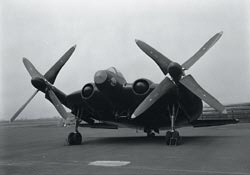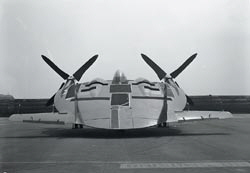|
|||||||
|
Basic characteristics were:
The wing, the basic outline of which was defined by two ellipses, so arranged that the major axis of one coincided with the minor of the other, comprised the main structure of the airplane, with the exception of the pilot’s cockpit and the horizontal and vertical tail surfaces. The greater part of the wing surfaces and internal structure was composed of Metalite, a “sandwich” material providing a particularly strong and light type of construction. The four-bladed counter-rotating propellers were driven by cross-shafting and gear boxes connected to both engines. If one engine failed, it could be de-clutched from the system and the airplane flown with the remaining engine and both propellers operating. Circular air intakes in the wing leading edge provided carburetor, engine and oil cooling air. Two vertical tails with rudder and fins provided directional control. Two Metalite ailavators, with trim tabs across 70% of their trailing edge and with balance weights on the tips, provided lateral and longitudinal control. The pilot’s cockpit was a complete monocoque shell with a formed plexiglass canopy. The stick and rudder flight controls were manual except for proportional hydraulic boost to the ailavators. Neither the first nor second airplane had armament, although there were provisions for six 50-caliber machine guns and ammo boxes. Two Pratt and Whitney R-2000-7 radial engines with cooling fans and superchargers were mounted upright in the wing. The 16-foot diameter propellers were unique for the time and bear some mention. Because of the activity factor, twist and shape, the props were manufactured by Chance Vought Aircraft of Stratford, Connecticut. The two hydraulically operated, fast-acting, electro-mechanically governed propellers each had four Pregwood blades and load-relieving hubs which differed from the conventional four-way hub in that the blades were free to “flap” in pairs about the shaft axis. Low pitch stop was 15 degrees, high pitch stop was 70 degrees. The propeller pitch control set the left-hand propeller governor mechanism which controlled the right-hand propeller governor mechanism electronically and adjusted the propeller blade angle. Movement of the pitch control lever upward decreased pitch, and downward increased the pitch. Full forward position governed takeoff rpm (2,700): full aft position gave approximately 1,300 rpm in take-off slot and 800 rpm for flight. These were propeller rpm’s. There was also the more conventional throttle control which operated in three slots: “WARM-UP”, “TAKE-OFF” and “FLIGHT”.
Another unique feature of the XF5U-1 was the stability flap, located symmetrically about the centerline of the airplane at the wing trailing edge. The 15 sq. ft. hinged surface required no pilot control but automatically provided for change in airplane trim with change in attitude. The air loads upon the flap adjusted deflection against a spring loaded strut. The stability flap was linked to the tail wheel to insure locking in the up position when the tail wheel was extended.
|

 The XF5U-1 was designed as a land-based or carrier-based fighter to be used with or without a catapult, with an arresting gear. The airplane incorporated certain unusual design and structural features.
The XF5U-1 was designed as a land-based or carrier-based fighter to be used with or without a catapult, with an arresting gear. The airplane incorporated certain unusual design and structural features.
